Hyundai Accent: Heating, Ventilation and Air Conditioning / Air Conditioning System
General Safety Information and Caution ➤
Description and Operation
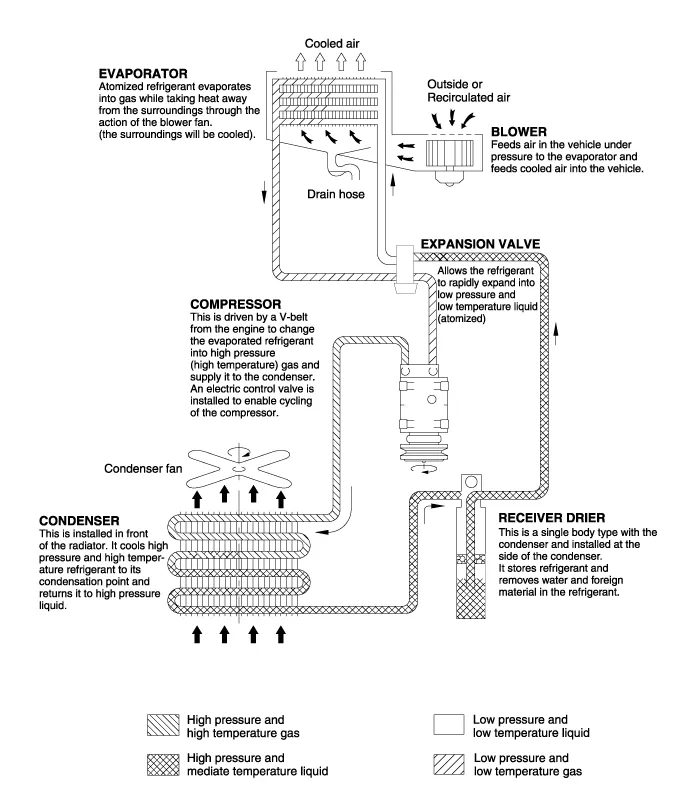
Repair procedures ➤
Components and Components Location
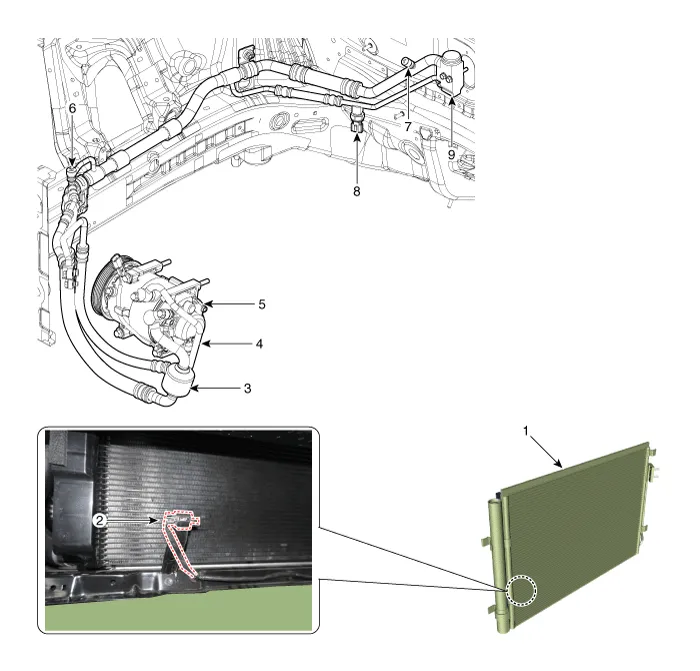
1. Condenser
2. Ambient temperature sensor
3. Suction & Liquid tube assembly
4. Discharge hose
5. Compressor
6. Service port (High pressure)
7. Service port (Low pressure)
8. A/C Pressure transducer (APT)
9. Expansion valve
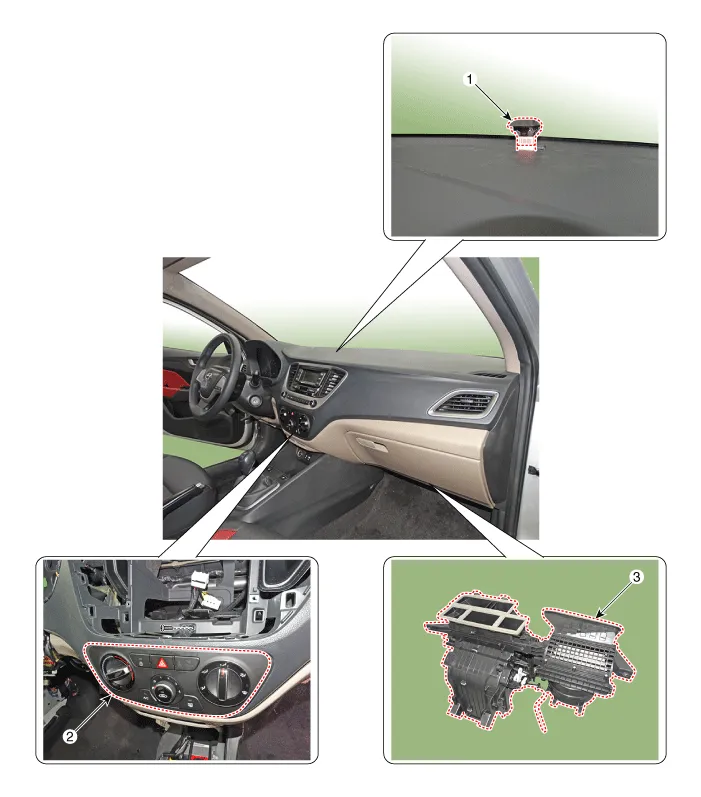
1. Photo sensor
2. Heater & A/C control unit
3. Heater & Blower unit
Compressor oil
1.The R-1234yf system requires synthetic (PAG) compressor oil whereas the R-12 system requires mineral compressor oil. The two oils must never be mixed.
2.Compressor (PAG) oil varies according to compressor model. Be sure to use oil specified for the model of compressor.
1.The oil should be free from moisture, dust, metal powder, etc.
2.Do not mix with other oil.
3.The water content in the oil increases when exposed to air. After use, seal oil from air immediately. (R-1234yf Compressor Oil absorbs moisture very easily.)
4.The compressor oil must be stored in steel containers, not in plastic containers.
Oil total volume in systemFD46XG(IDEMITSU) 110 ± 10cc (3.72 ± 0.34oz.)
1.Open all the doors and engine hood.
2.Start the engine and air conditioning switch to "ON" and set the blower motor control knob at its highest position.
3.Run the compressor for more than 20 minutes between 800 and 1,000 rpm in order to operate the system.
4.Stop the engine.
Refrigerant Line
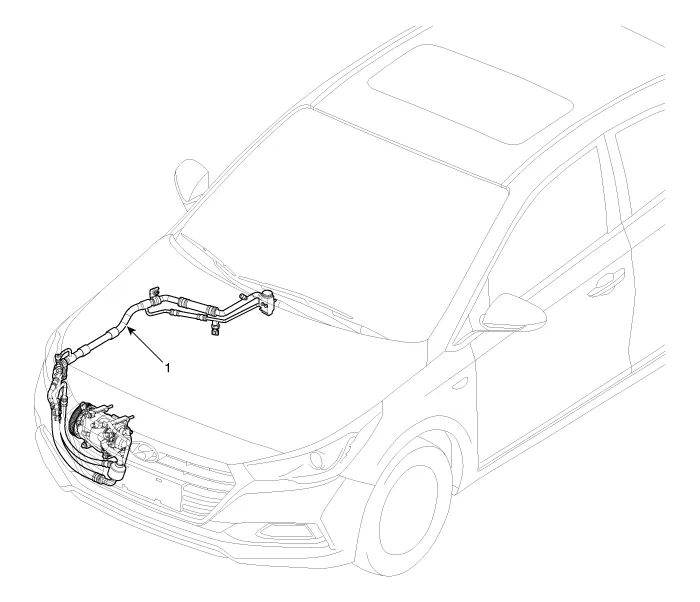
1. Refrigerant line assembly
1.If the compressor is marginally operable, run the engine at idle speed, and let the air conditioning work for a few minutes, then shut the engine off.
2.Disconnect the negative (-) battery terminal.
3.Recover the refrigerant with a recovery / charging station.
4.Remove the bolts and the expansion valve (A) from the evaporator core.
Tightening torque :8.8 - 13.7 N.m (0.9 - 1.4 kgf.m, 6.5 - 10.1 Ib-ft)
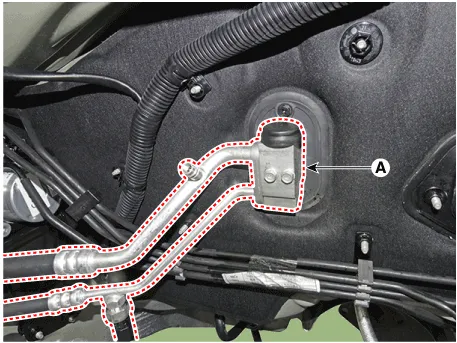
5.Remove the 2 nuts, and then disconnect the discharge line (A) and liquid line (B) from the condenser.
Tightening torque :8.8 - 13.7 N.m (0.9 - 1.4 kgf.m, 6.5 - 10.1 Ib-ft)
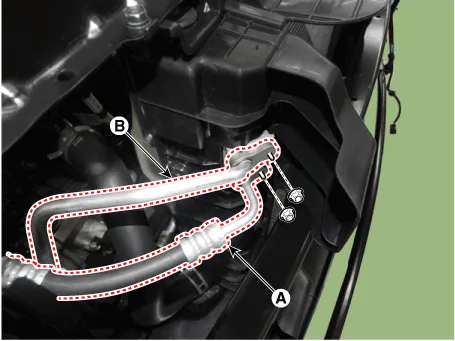
6.Disconnect the A/C pressure transducer connector (A).
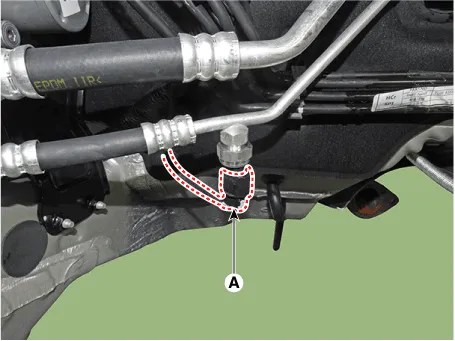
7.Remove the engine room under cover.(Refer to Engine Mechanical System - "Engine Room Under Cover")
8.Remove the bolts, then disconnect the suction line (A) and discharge line (B) from the compressor.
Tightening torque :21.6 - 32.4 N.m (2.2 - 3.3 kgf.m, 15.9 - 23.9 Ib-ft)

• Plug or cap the lines immediately after disconnecting them to avoid moisture and dust contamination.
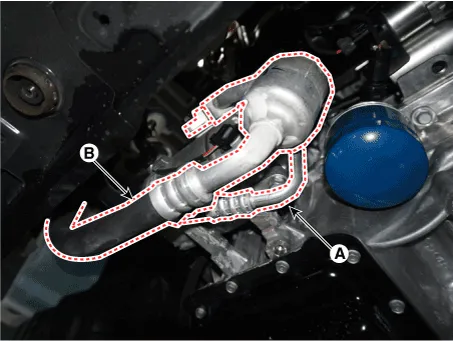
9.Loosen the bracket mounting bolt (B) from suction& liquid assembly (A).
Tightening torque :(B) : 7.8 - 11.8 N.m (0.8 - 1.2 kgf.m, 5.8 - 8.7 Ib-ft)(C) : 8.8 - 13.7 N.m (0.9 - 1.4 khf.m, 6.5 - 10.1 lb-ft)
10.Remove the refrigerant line assembly (A) to the upper of engine room.
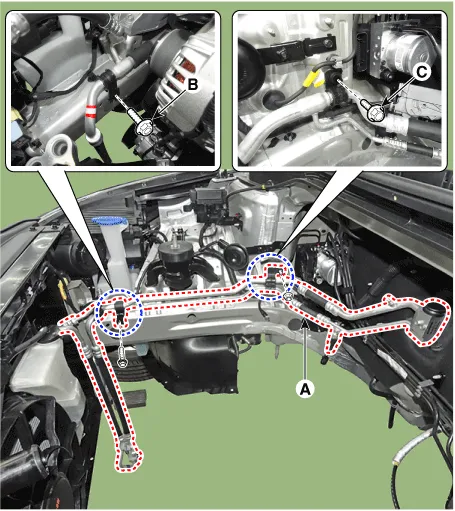
11.To install, reverse the removal procedure.

• Plug or cap the lines immediately after disconnecting them to avoid moisture and dust contamination.
• Tighten the bolt or nut joint to the specified torque.
• Using a gas leak detector, check for refrigerant leakage.
• Evacuate air in the refrigeration system and charge system with refrigerant.
Capacity : 480 ± 25 g (16.9 ± 0.88 oz.)
• When replacing and re-installing the A/C system, do not reuse the seal washer. After replacement, please discard components.
Compressor ➤
Condenser
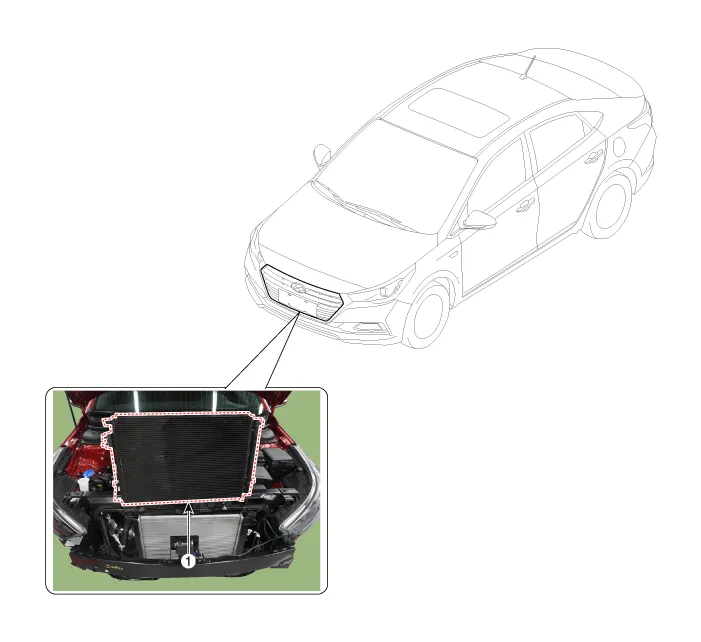
1. Condenser
1.Check the condenser fins for clogging and damage. If clogged, clean them with water, and blow them with compressed air. If bent, gently bend them using a screwdriver or pliers.
2.Check the condenser connections for leakage, and repair or replace it, if required.
1.Recover the refrigerant with a recovery / recycling / charging station.
2.Disconnect the negative (-) battery terminal.
3.Remove the front bumper.(Refer to Body - "Front Bumper Cover")
4.Remove the horn.(Refer to Body Electrical System - "Horn")
5.Remove the upper air guard.(Refer to Engine Mechanical System - "Cooling Fan")
6.Remove the nuts, and then disconnect the discharge line (A) and liquid line (B) from the condenser.
Tightening torque :8.8 - 13.7 N.m (0.9 - 1.4 kgf.m, 6.5 - 10.1 lb-ft)
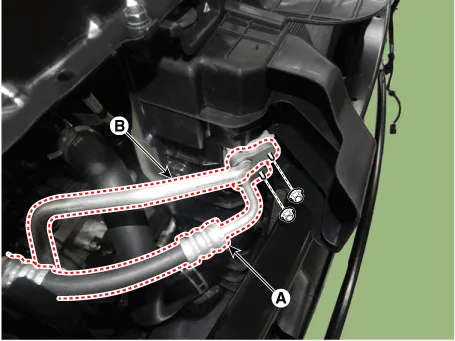
7.Loosen the mounting pin - type retainers and bolts, remove the side air guard (A).
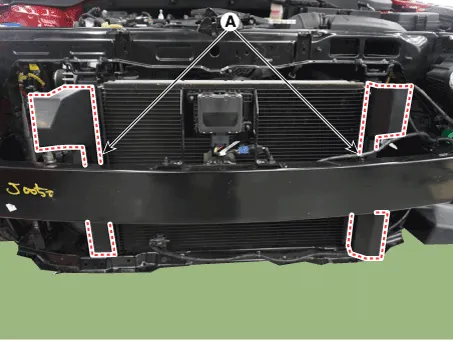
8.After loosening the mounting bolts, remove the intake shield (A).
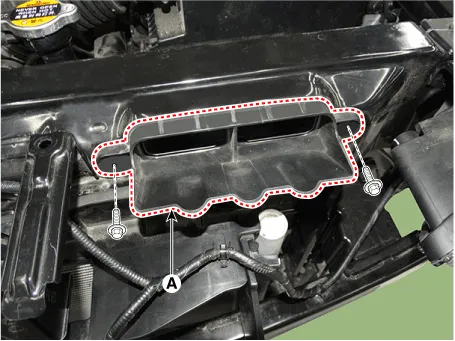
9.Remove the condenser (A) from radiator.
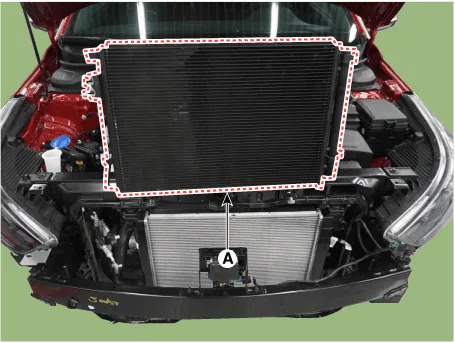
10.To install, reverse the removal procedure.

• When replacing and re-installing the A/C system, do not reuse the seal washer. After replacement, please discard components.
• If you're installing a new condenser, add refrigerant oil.
• Replace the O-rings with new ones at each fitting, and apply a thin coat of refrigerant oil before installing them. Be sure to use the right O-rings for R-1234yf to avoid leakage.
• Be careful not to damage the radiator and condenser fins when installing the condenser.
• Charge the system, and test its performance.
Receiver-Drier
1.Remove the condenser.
2.Remove the cap (A) on the bottom of the condenser with a L wrench.
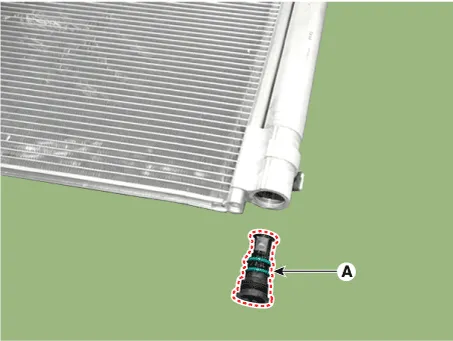
Tightening torque :2.8 - 3.3 N.m (0.29 - 0.34 kgf.m, 2.1 - 2.5 lb-ft)
3.Remove the receiver - drier (A) from condenser using a long nose plier. Check for crumbled receiver - drier and clogged bottom cap filter.
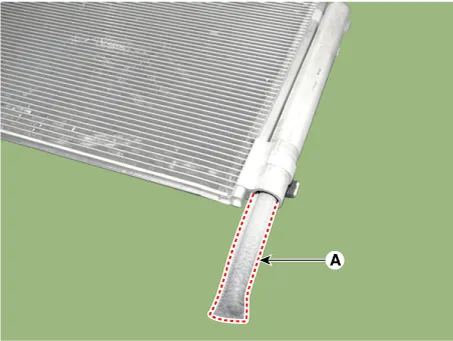
4.Apply air conditioning compressor oil along the O-rings and threads of the new bottom cap.
5.Insert a new receiver-drier into the receiver drier tank. The receiver-drier must be sealed in vacuum before it is exposed to air for use.
6.Install a new bottom cap to the condenser.

• When replacing and re-installing the A/C system, do not reuse the seal washer. After replacement, please discard components.
• Always replace the receiver-drier and bottom cap at the same time.
• Be careful not to damage the radiator and condenser fins when installing the condenser.
• Charge the system, and test its performance.
• Replace the O-rings (A) with new ones at each fitting, and apply a thin coat of refrigerant oil before installing them. Be sure to use the right O-rings (A) for R-1234yf to avoid leakage.
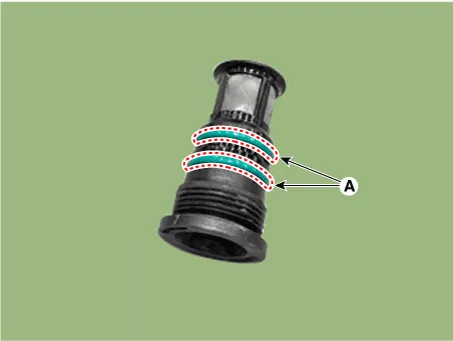
A/C Pressure Transducer ➤
Evaporator Temperature Sensor ➤
In-car Sensor
1.The heating, ventilation and air conditioning can be quickly diagnosed failed parts with vehicle diagnostic system (GDS).※ The diagnostic system (GDS) provides the following information.(1) Self diagnosis : Checking the failure code (DTC) and display.(2) Current data : Checking the system input / output data state.(3) Actuation test : Checking the system operation condition.(4) Additional function : Other controlling such as he system option and zero point adjustment.
2.Select the 'Car model' and the system to be checked in order to check the vehicle with the tester.
3.Select the 'Current data' menu to search the current state of the input / output data.The input / output data for the sensors corresponding to the In - car Sensor can be checked.
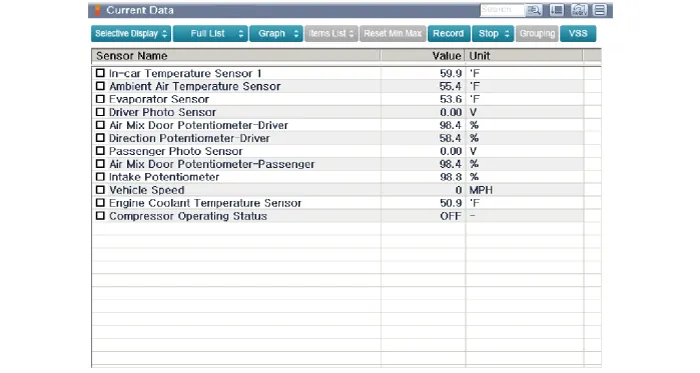
Photo Sensor
1.Turn the ignition switch ON.
2.Connect the GDS.
3.Emit intensive light toward the photo sensor using a lamp, and check the output voltage change.
4.The voltage will rise with higher intensive light and reduce with lower intensive light.
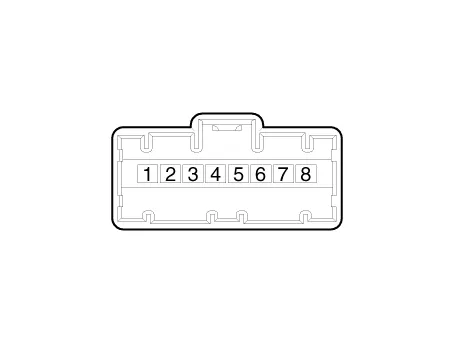
1. Auto light signal
2. Auto light ground
3. Photo signal (RH)
4. LED power (B+)
5. LED ground (To BCM)
6. Photo signal (LH)
7. Photo power
8. Auto light power (5V)
1.Disconnect the negative (-) battery terminal.
2.Using a screwdriver or remover, remove the photo sensor (A).
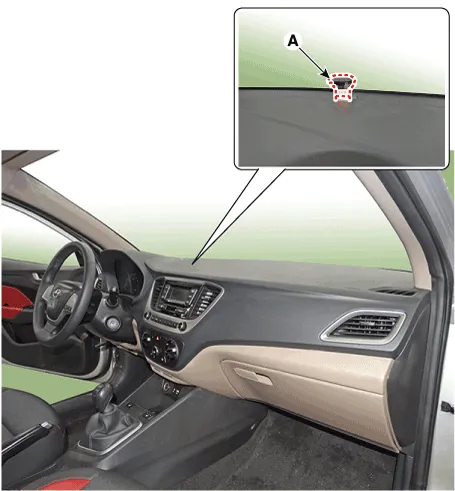
3.To install, reverse the removal procedure.
Ambient Temperature Sensor ➤
Other information:
Hyundai Accent (HC) (2017 - 2022) Service Manual: Description and Operation
- Description This specification applies to HCU (Hydraulic Control Unit) and ECU (Electronic Control Unit) of the HECU. (Hydraulic and Electronic Control Unit)This specification is for the wiring design and installation of ABS ECU.This unit has the functions as follows. – Input of signal from the wheel speed sensors attached to each wheel.Hyundai Accent (HC) (2017 - 2022) Service Manual: Specifications
- Specifications Ignition System Ignition Coil ItemSpecification Rated Voltage (V)13.5 Operation Voltage (V)6 - 16 ItemSpecification Engine Speed (RPM)100020003000400050006000 Dwell Time (ms)3.43.43.42.92.72.5 Secondary Coil Voltage (kV)40 ↑40 ↑40 ↑40 ↑40 ↑38 ↑ Spark plug ItemSpecification TypeSILZKR7E9 Gap0.8 - 0.9 mm (0.
Contents
- General Safety Information and Caution
- Description and Operation
- Repair procedures
- Components and Components Location
- Compressor oil
- Refrigerant Line
- Compressor
- Condenser
- Receiver-Drier
- A/C Pressure Transducer
- Evaporator Temperature Sensor
- In-car Sensor
- Photo Sensor
- Ambient Temperature Sensor
Categories
- Manuals Home
- Hyundai Accent Owners Manual
- Hyundai Accent Service Manual
- New on site
- Most important about car


